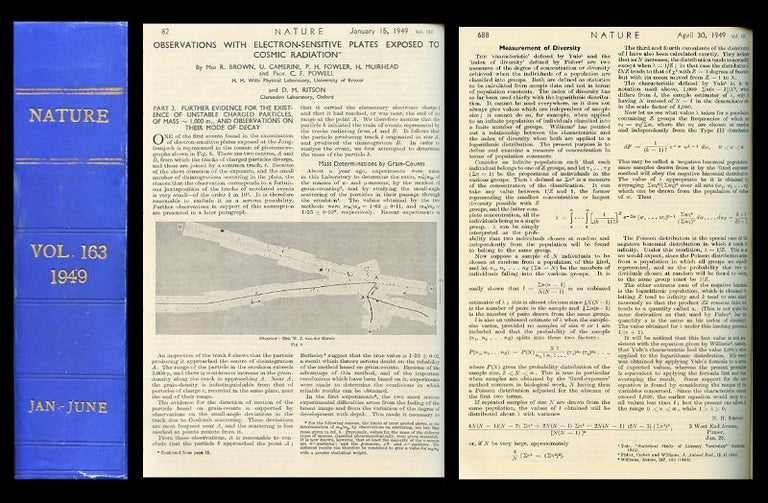Observations with Electron Sensitive Plates Exposed to Cosmic Radiation. II. Further Evidence for the Existence of Unstable Charged Particles of Mass ~ 1000 meand Observations on their Mode of Decay AND Measurement of Diversity Nature 163, 1949, pp. 82-87, pp. 688-689
London: Macmillan, 1949. 1st Edition. FIRST EDITIONS OF TWO PAPERS OF SIGNIFICANCE. The first is a Nobel Prize winning paper outlining the development of photographic techniques that greatly enhanced our ability to study nuclear processes and for the resulting discovery of the pion, a subatomic particle. The prize was awarded in 1950 to one of the authors, C. F. Powell. The second paper by Edward Simpson puts forward the Simpson Diversity Index; it “characterize[s] diversity based on the number of species present (species richness) and the distribution of the number of organisms per species (species evenness” (The American Naturalist 174, August 2009).
Powell and his co-authors invented a photographic method for detecting subatomic particles, which led to his discovery of a new particle called the pi-meson, or pion. “Developed new photographic techniques for directly recording the tracks of subatomic particles. He then exposed photographic plates at the tops of high mountains, or sent them up in high-altitude balloons, so as to be able to ‘photograph’ cosmic rays” (Dardo, Nobel Laureates, 230).
The Simpson Diversity Index presented in this volume measures the degree of concentration when individuals are classified into type. “A diversity index is a quantitative measure that reflects how many different types (such as species) there are in a dataset, and simultaneously takes into account how evenly the basic entities (such as individuals) are distributed among those types. The value of a diversity index increases both when the number of types increases and when evenness increases. For a given number of types, the value of a diversity index is maximized when all types are equally abundant” (Wikipedia). Item #506
CONDITION & DETAILS: London: Macmillan. Complete. 4to (Quarto). 10.5 x 7.5 inches (262 x 187mm). [lxiv], 1008, [2]. Ex-libris bearing no spine markings whatsoever; two small stamps on the front flyleaf, one on the rear pastedown, and one on the title page. In text illustrations throughout. Bound in lightly scuffed blue cloth, gilt-lettered at the spine. Tightly bound. Bright and clean inside.
Price: $175.00

